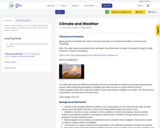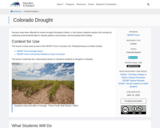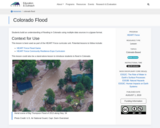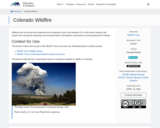
This is a video introduction from National Geographic about weather and climate with a follow-up read and respond activity.
- Subject:
- Earth and Space Systems
- Science
- Material Type:
- Activity/Lab
- Date Added:
- 11/22/2019

This is a video introduction from National Geographic about weather and climate with a follow-up read and respond activity.

In this CS First lesson, students will engage in hands-on coding activities to illustrate an energy transformation scenario of their choice, identifying and explaining at least four different types of energy involved in the process.

Explore the energy exchange between colliding objects and observe how energy transfer occurs under various circumstances.

Humans have been affected by severe drought throughout history; in this lesson students explore this concept by analyzing environmental data to classify patterns and practice communicating their findings.

Students build an understanding of flooding in Colorado using multiple data sources in a jigsaw format.

Wildfires are occurring more frequently and increasing in size in the western US; in this lesson students will explore this concept by analyzing environmental data to find patterns and practice communicating their findings.

This resource provides a summary of common preconceptions and misconceptions in Life Science.

This resource provides a summary of common preconceptions and misconceptions in Life Science.

This resource provides a summary of common preconceptions and misconceptions in Life Science.

In this sub-unit, students will learn more about their community���s resilience plans, choose a specific topic to focus on, and develop a product to communicate the plan to their peers and/or their community.

The Community Resilience Expo is a culminating event for the HEART Force curriculum, where students will develop and present original ideas to increase resilience in their community.

Investigate the difference in attractive force between polar and non-polar molecules by 'pulling' apart pairs of molecules. While all molecules are attracted to each other, some attractions are stronger than others. Non-polar molecules are attracted through a London dispersion attraction; polar molecules are attracted through both the London dispersion force and the stronger dipole-dipole attraction. The force of attractions between molecules has consequences for their interactions in physical, chemical and biological applications.

Explore the difference in attractive forces between polar and nonpolar molecules.

Investigate the difference in attractive force between polar and non-polar molecules by "pulling" apart pairs of molecules. While all molecules are attracted to each other, some attractions are stronger than others. Non-polar molecules are attracted through a London dispersion attraction; polar molecules are attracted through both the London dispersion force and the stronger dipole-dipole attraction. The force of attractions between molecules has consequences for their interactions in physical, chemical and biological applications.

Students will examine a map projection of a chosen USGS topographic map versus other maps. The teacher will explain that each map is drawn according to a specific map projection. Students will be given or shown a USGS poster of numerous map projections, as well as cartography in texts to illustrate how distance, direction, angle, or area have to be distorted.

Students will examine a map projection of a chosen USGS topographic map versus other maps. The teacher will explain that each map is drawn according to a specific map projection. Students will be given or shown a USGS poster of numerous map projections, as well as cartography in texts to illustrate how distance, direction, angle, or area have to be distorted.

Compare the change in potential energy when you separate molecules from each versus when you break molecules apart.

In this lesson, students will be given the opportunity to identify whether objects are solids, liquids, or gasses, based on the attributes of each object.

Explore a NetLogo model of populations of rabbits, grass, and weeds. First, adjust the model to start with a different rabbit population size. Then adjust model variables, such as how fast the plants or weeds grow, to get more grass than weeds. Change the amount of energy the grass or weeds provide to the rabbits and the food preference. Use line graphs to monitor the effects of changes you make to the model, and determine which settings affect the proportion of grass to weeds when rabbits eat both.

After the completion of this module students will understand that sound travels in compression waves and must have a medium to travel. Sound also travels in liquids and gases. Students will also understand that sound waves are created by vibrations and capable of transmitting energy.This module was developed by Sarah Donnelly as part of a Virginia Commonwealth University STEM initiative sponsored by the Virginia Department of Education.